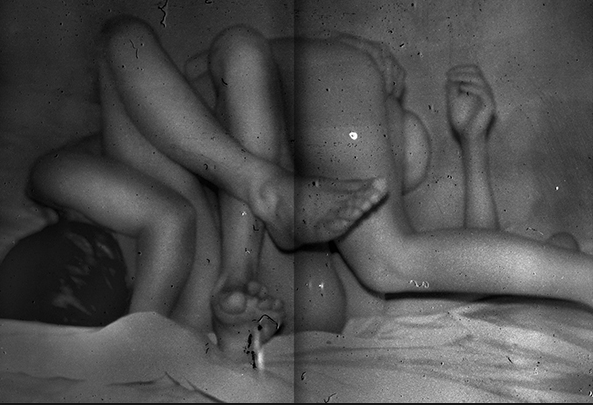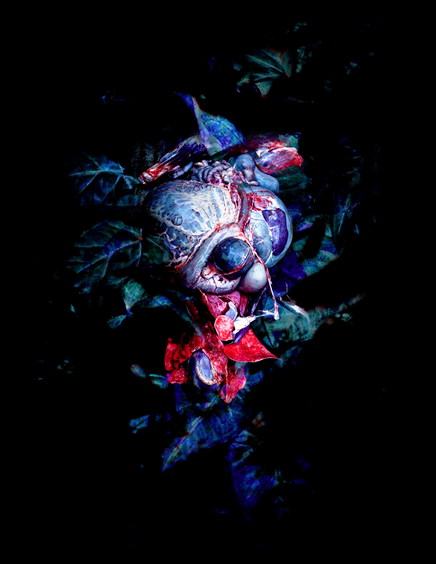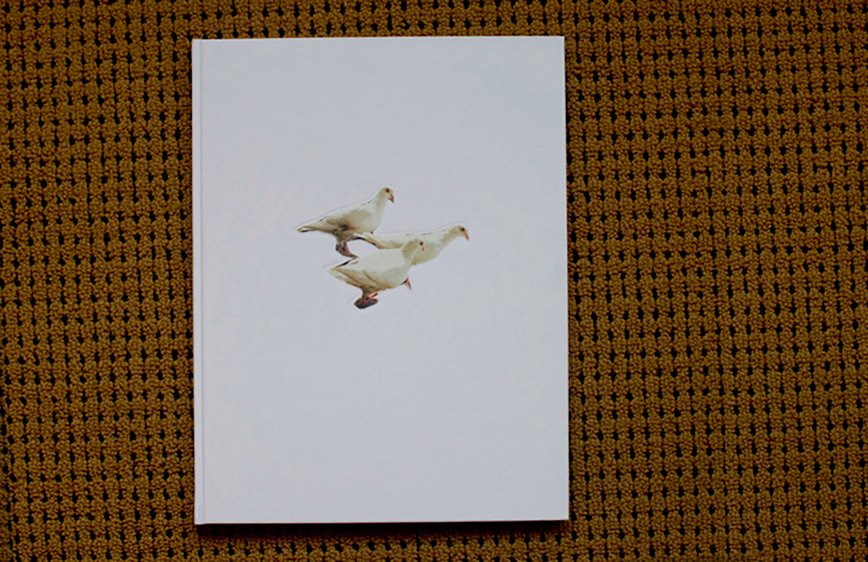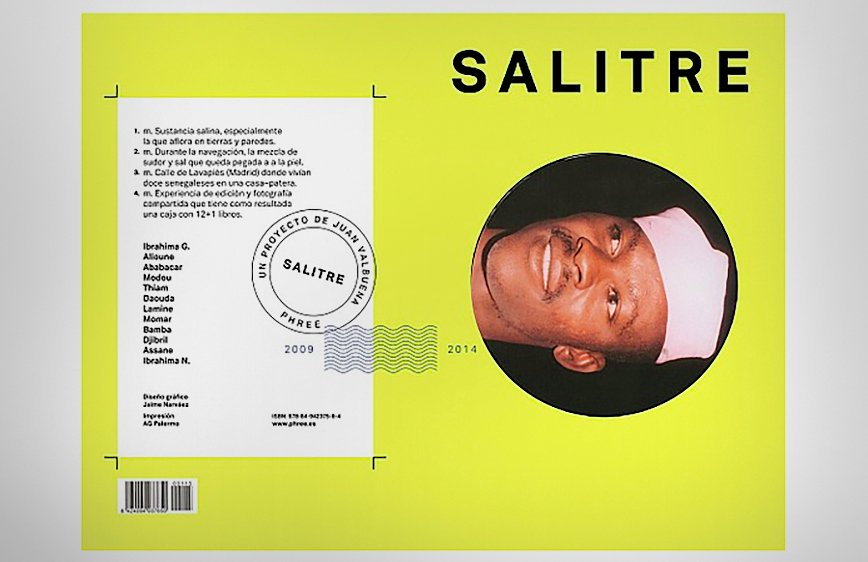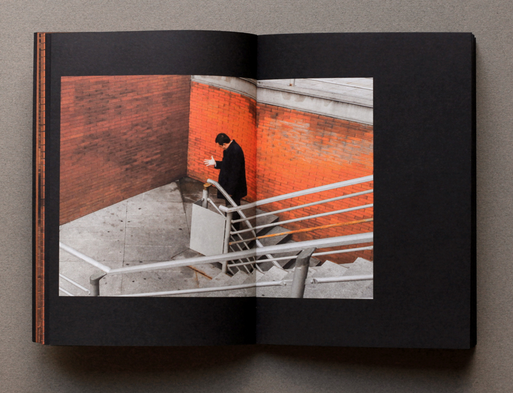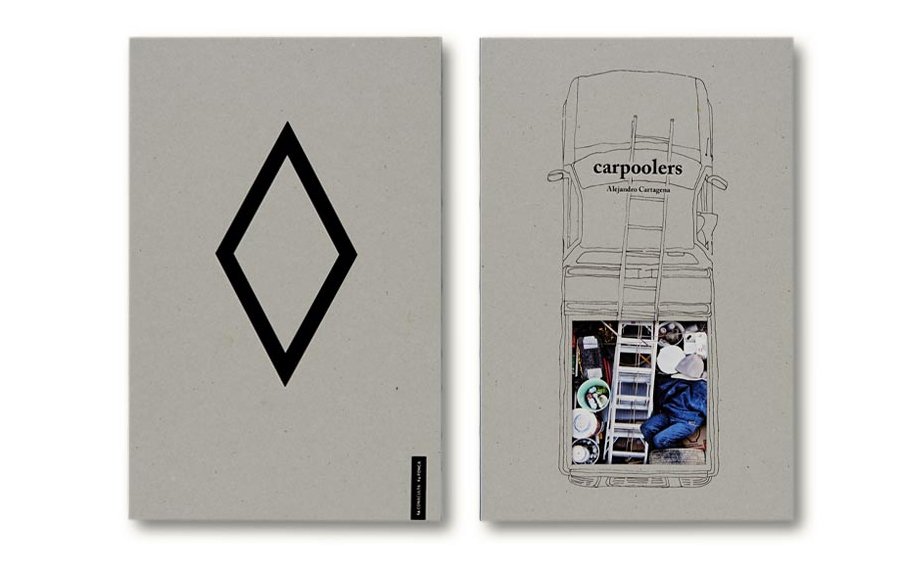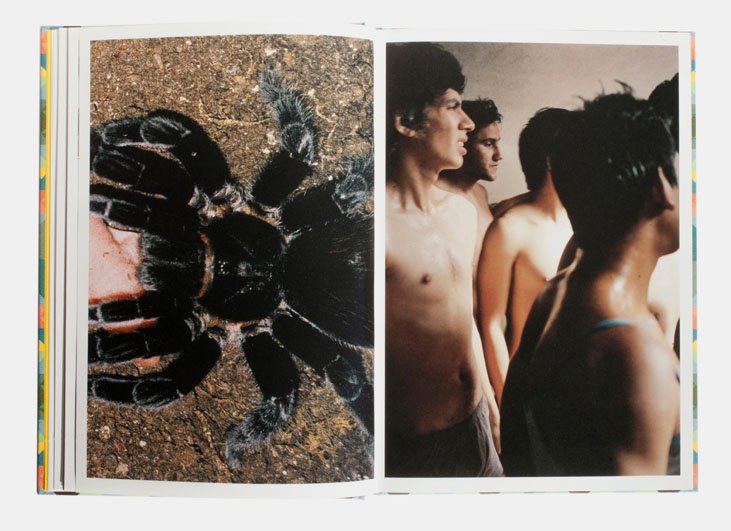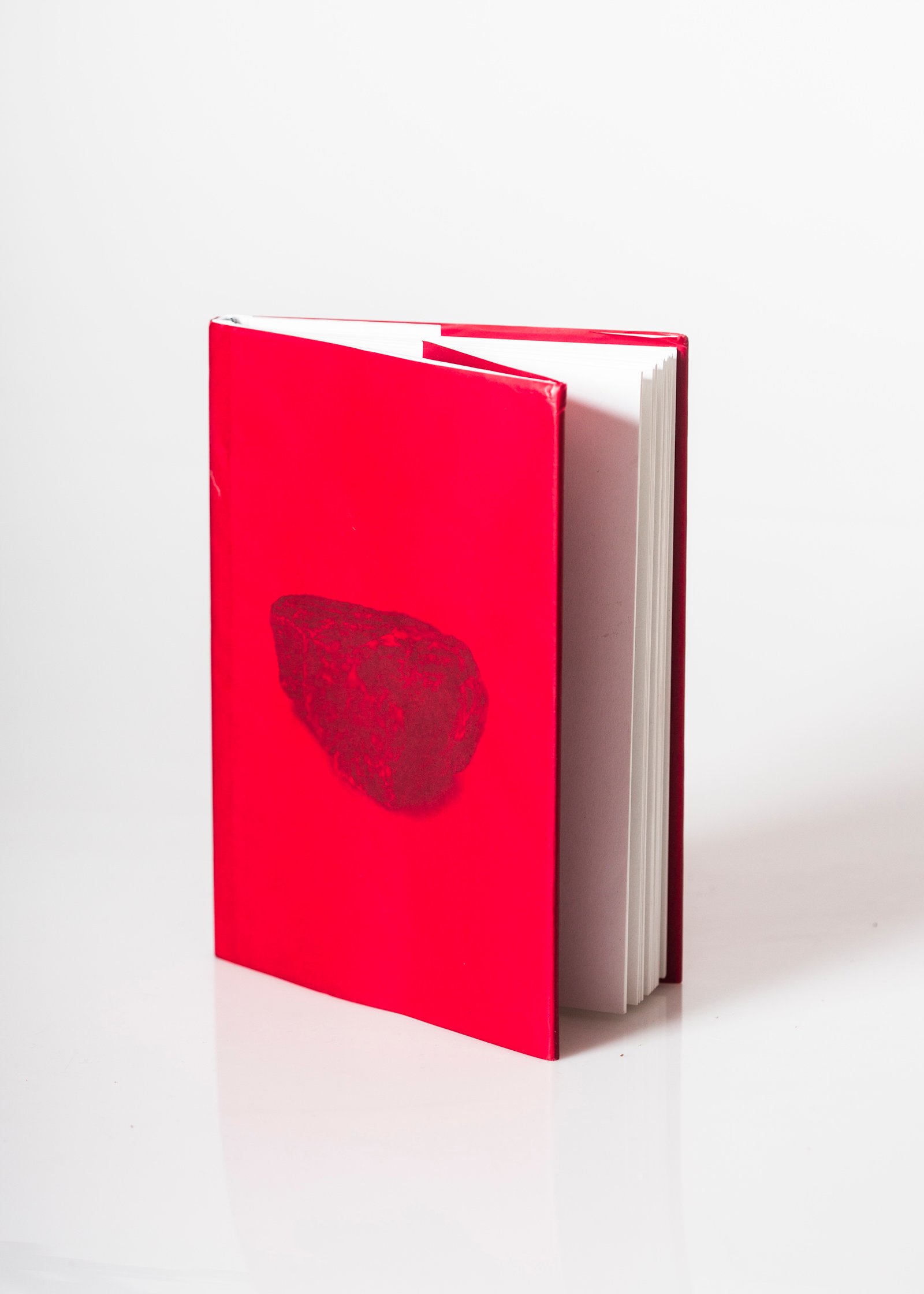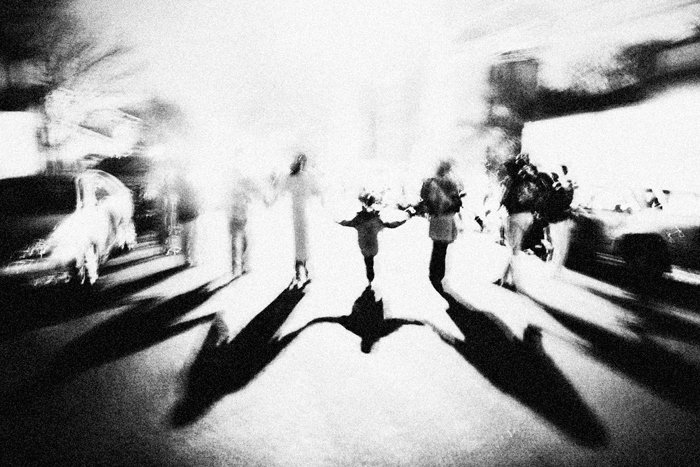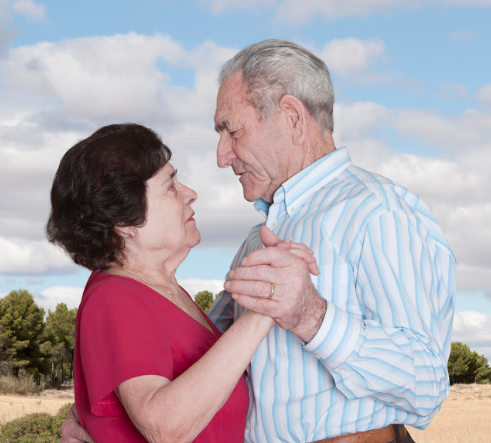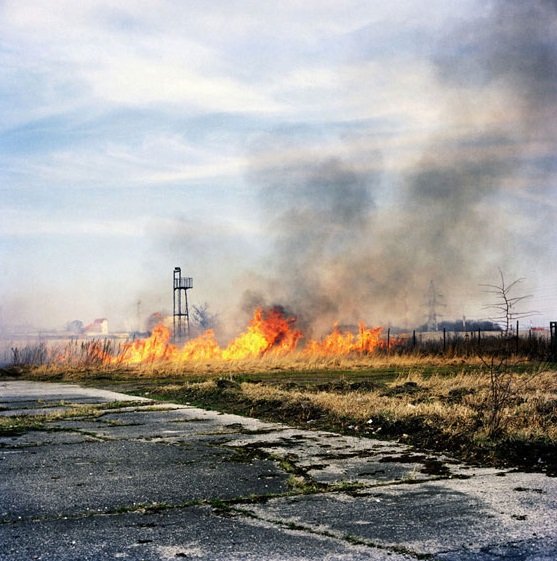Selected by Markus Schaden
Markus Schaden, b. 1965 , bookseller, publisher and curator for Photography, owner of schaden.com, director of The PhotoBookMuseum, lives in Cologne Germany and works worldwide.
1. BERLIN by Mark Power – Self published 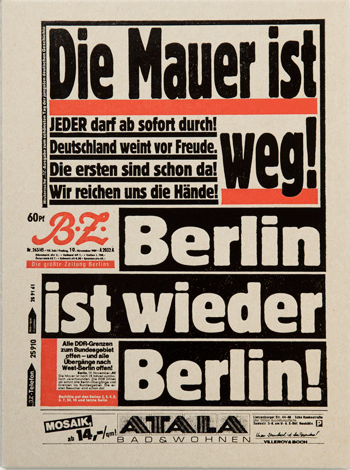
On the spot. A historic moment in history and special for germans like me -who were sitting faithless in front of th tv screen. The night of the Berlin Wall Fall at the checkpoint Bornholmer Strasse. We know only a small footage movie from Bornholmer Strasse for now, and Mark Power was there , too! Shooting pictures. 25 years ago He made a fantastic self made book tributing the night of the nights . Incredible touching. And a visual impressive statement with his camera. Thank you Mark! Fantastic .
2. WILD PIGEON by Carolyn Drake – Self published

Carolyn Drake could surprise me with the TWO RIVERS book. But in WILD PIGEON Drake turned her political and social view on a region 2000 miles away from Bejing into a new challenge. Brilliant solution for a complex problem and brilliant solution from SYB designer into a great photobook.
3. Books and Films 1947-2014 by Robert Frank, Publisher: Steidl and SZ

A catalogue in form of a full classic newspaper format (including weather report of Mabou!). Great idea and work of german SZ Newspaper and curated by Alex Rühle, printed at Steidl. The most famous living photographer(sic!) felt like in heaven seeing the catalogue and this show -also in newspaper-style -print. ” Nothing left for the art market ” Frank said seeing the first copy and used it after reading to burn on his oven ! Chapeau ! Price like newspaper…
4. PURITY by David Magnusson, Publisher: Bokförlaget Max Ström

Purity by David Magnusson made me wake up suddenly in the night. This book is so disturbing especially when you are a dad of 3 daughters in the age of 2,4 and 7. Its picturing a relation between daughters and fathers I never seen before. This book pushed me into a mood of permant thinking . What a amazing quality for a photobook . Gratulation David!
5. THE EPILOGUE by Laia Abril, Publisher: Dewi Lewis

[divider]
Daisuke Yokota was born in Saitama, Japan, in 1983.Yokota had a solo exhibition, Site/Cloud, at G/P gallery in 2013.and selected for the first OUTSET UNSEEN AWARD in 2013, and his first solo exhibition in Europe was successfully ended at Foam Museum in July 2014. Recently he is working as a member of an international artists collective called AM projects.
1. TIEGARTEN By Johannes Schwartz, Publisher: Roma publications

A litho-printed artist book, mainly featuring photographs of food given to animals at a Moscow zoo. The photos are fragmented, and laid out simply and rhythmically. Because the objects have been photographed, their original smell and feel has been lost. But through the selection of soft, thick paper, and the use of lithograph printing, the food takes on a new, warm feel and smell. The elasticity of the ring binding feels wonderful in the hand.
2. OUT OF ORDER By Penelope Umbrico, Publisher: RVB Books

This book is unbinded, and printed on paper of various different sizes and textures. The indoor, black and white images of desks and other objects give an inorganic, restless feeling. In between these photos are inserted color images of household plants. Death in bankruptcy. In its ruins, there are no human figures. Household plants were meant for human appreciation lose their usefulness, and it is if their original form as dead bodies are being displayed on the Internet.
3. ROCK WAVES By Sam Falls, Publisher:Karma
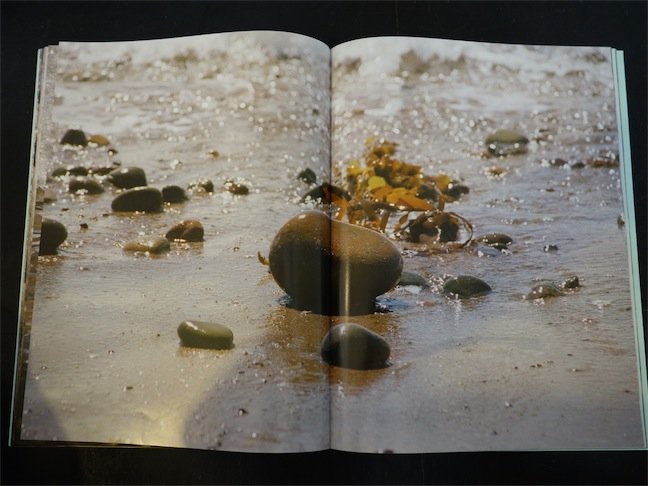
A stripped down, simple photography collection, without unnecessary decoration. In a scene of beautiful light, a wave crashes into a rock and sprays into the air. This scene continues there at the peaceful beach from the beginning to the end. However, the time of the wave swallowing the rock back into the water is not shown. The continually changing reality of nature is extracted from the peacefully and endlessly continuing succession of time.
4. CLOSE YOUR EYES by Gareth McConnell, Publisher: SPBH EDITIONS

These images, which become more psychedelic and colorful with each reproduction, primarily consists of reprocessed images of the artist’s own past work – copies made through a monitor screen, copies of printed materials, and so on. Like the ethereal flashbacks that appear when you close your eyes when in a drug-induced haze, a sense of otherworldly stop-motion-like time is recreated in this book.
5. FRIENDS FOREVER By Kenta Kobayashi, Self-published
The artist resides in a Shibuya sharehouse called “Shibuhouse”, in which around 40 young people live. At first, the graphically extreme effects used seem to kill the photo-ness (that is, the realism) of the images. However, to the artist’s generation, in which computers were common by the time they were children, perhaps “nature” is something that has already been digitally warped. Analog versus digital, reality versus fiction, perhaps these are no longer separate. The world that we see through the filter of our heads feeds back into reality.
[divider]
Selected by Hans Gremmen
Hans Gremmen (1976, NL) is a graphic designer, working in the field of photography, architecture and fine arts. He edited and curated the book and exhibition ‘Objects in Mirror – The Imagination of the American Landscape’ and made a five hour movie ‘The Mother Road’ about Route 66. Gremmen works for publishers as Aperture, Architecture& Natura and Roma Publications, and is one of the founders of photobook publisher Fw:Books. Recently he received the Golden Medal for the ‘Schönste Bücher aus aller Welt’, for the design of book ‘Cette Montagne, C’est Moi’.
1. HOME IS WHERE THE DOG IS by Erik Van Der Weijde, Publisher: 4478zine
The seemingly effortlessness way how Van der Weijde makes books is admirable. Humor is often undervalued within photography. Erik uses this important tool in a clever and direct way.
2. PROFILERATION by Geert Goiris, Publisher: Roma Publications
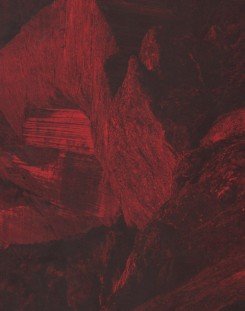
Perfect example of a catalogue being more then a catalogue, but becomes a exhibition-space in paper. Perfect.
3. PHOTOGRAPHS FOR DOCUMENTS by Vytautas V. Stanionis, Publisher: Kaunas Photography Gallery
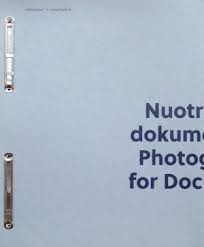
The straightforward design adds in a disarming and beautiful way a new layer to the content.
4. THE PHOTOGRAPHER’S PLAYBOOK by Jason Fulford & Gregory Halpern, Publisher: Aperture
No photographs in this book, but it is one of the most inspiring photography books in a long time. Showing the medium is always debatable, inspiring, contradicting, and so much more.
5. VIEW, KYOTO by Jacqueline Hassink, Publisher: Hatje Cantz

This is in my opinion one of the strongest bodies off work in Hassink’s impressive oeuvre. The photographs itself are monumental in composition, but presented in a intimate way. An approach which touches on one off the core elements of the topic of the book.
[divider]
Selected by Manik Katyal
Founder and Editor-in-Chief, Emaho Magazine
For the first time ever, Daisuke presents his nude photography, is an interesting mix of fiction and reality merged together.

Ramya is my favourite book from 2014. The simplicity of the book with a very intimate relation of the photographer and the photographed, documented over 14 years is a sheer visual delight.

Another one is wit, charm, and artfulness of Thomas Mailaender, made in collaboration with the Archive of Modern Conflict, where he applied powerful UV red lamp to the human skin and developed negatives on it.
1. THE NINETY NINE AND THE NINE by Katy Grannan, Publisher: Fraenkel Gallery Publications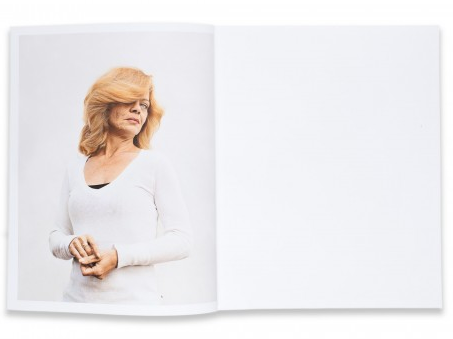 Katy Grannan‘s recent photographs were taken in the parched landscape and forgotten towns along Highway 99 in California¹s Central Valley and Modesto‘s South 9th Street (referred to as The Nine) and along the banks of the Tuolumne River. The book consists of two large-format volumes in a slipcase. One volume (99) contains very sensitive and powerful color portraits of people on the fringes of society, taken in front of neutral white backgrounds in glaring sunlight; the other volume (9) black–and-white scenes of small apparent trivialities, which, like staged film stills, immediately involve one in the action with these junkies, prostitutes and homeless people. A fantastic story collection in a double pack.
Katy Grannan‘s recent photographs were taken in the parched landscape and forgotten towns along Highway 99 in California¹s Central Valley and Modesto‘s South 9th Street (referred to as The Nine) and along the banks of the Tuolumne River. The book consists of two large-format volumes in a slipcase. One volume (99) contains very sensitive and powerful color portraits of people on the fringes of society, taken in front of neutral white backgrounds in glaring sunlight; the other volume (9) black–and-white scenes of small apparent trivialities, which, like staged film stills, immediately involve one in the action with these junkies, prostitutes and homeless people. A fantastic story collection in a double pack.
2. NATIONALFEIERTAG / NATIONAL DAY by Katja Stuke, Publisher: Boehm Kobayashi
The Chinese National Day is celebrated annually on 1 October. On this day in 2011, Katja Stuke filmed people on Beijing’s Square of Heavenly Peace and in 2014 in Hong Kong during the protests commemorating the anniversary of the massacre that took place on the Square of Heavenly Peace in 1989. In her typically distant rendition of pictures photographed from monitors, she creates with these 100 portraits a media kaleidoscope of very determined images of people who mirror all of the extreme contradictions of the official and the actual realities of China. Next to her portraits are historical black+white images and small inserted text sheets that illustrate China’s role in the world of fashion, industry and globalization. This thick, comprehensive book with its unusual cover and high-volume uncoated paper is surprisingly light to hold and therefore incorporates a special contradiction even as an object.
3. PARTICULARS by David Goldblatt, Publisher: Steidl After creating a series of portraits in the early seventies, David Goldblatt focused for a short, intensive time on the physical details and individual body languages of his compatriots, as, in his words, “affirmations or embodiments of their selves.“ These incredibly strong black–and-white images were first shown in 2003 in a book by the Goodman Gallery Johannesburg. Here they are available in an opulent version newly compiled by David Goldblatt, that impressively meets Gerhard Steidl‘s most exacting demands for maximum print quality. It is this wonderful print quality too, which leaves one speechless.
After creating a series of portraits in the early seventies, David Goldblatt focused for a short, intensive time on the physical details and individual body languages of his compatriots, as, in his words, “affirmations or embodiments of their selves.“ These incredibly strong black–and-white images were first shown in 2003 in a book by the Goodman Gallery Johannesburg. Here they are available in an opulent version newly compiled by David Goldblatt, that impressively meets Gerhard Steidl‘s most exacting demands for maximum print quality. It is this wonderful print quality too, which leaves one speechless.
4. LAMBE LAMBE by Joachim Schmid, Publisher: Editorial RM In 1992 and 1993, in a public place in Belo Horizonto, Brazil, Joachim Schmid found discarded black+white negatives by portrait photographers, which were created in extremely basic conditions for administrative purposes. They were developed in situ as contact prints using a simple dark room box and so could be given directly to the people portrayed. The corresponding negatives were thrown away. In 2002, Schmid returned to Belo Horizonte and again found discarded, negatives but this time they were color negatives. This volume combines the printed black+white and the color portraits of nameless faces from Belo Horizonte, printed from the found negatives. They are more expressive than most of what is known as portrait photography. The book belongs in the front row of a history of portrait photography in the photobook.
In 1992 and 1993, in a public place in Belo Horizonto, Brazil, Joachim Schmid found discarded black+white negatives by portrait photographers, which were created in extremely basic conditions for administrative purposes. They were developed in situ as contact prints using a simple dark room box and so could be given directly to the people portrayed. The corresponding negatives were thrown away. In 2002, Schmid returned to Belo Horizonte and again found discarded, negatives but this time they were color negatives. This volume combines the printed black+white and the color portraits of nameless faces from Belo Horizonte, printed from the found negatives. They are more expressive than most of what is known as portrait photography. The book belongs in the front row of a history of portrait photography in the photobook.
5. A ROAD THROUGH SHORE PINE by Robert Adams, Publisher: Fraenkel Gallery Publications There are books that, as soon as I have turned the first pages, elicit from me a profound wow! Once again it happened with a Robert Adams book. A Road Through Shore Pinefocuses on a series of 18 photographs taken in Nehalem Bay State Park, Oregon, in the fall of 2013, along an isolated tree-lined road to the sea. The outstanding printing quality, the simplicity of the images, the minimalist layout, and the depth of its view. Very impressive.
There are books that, as soon as I have turned the first pages, elicit from me a profound wow! Once again it happened with a Robert Adams book. A Road Through Shore Pinefocuses on a series of 18 photographs taken in Nehalem Bay State Park, Oregon, in the fall of 2013, along an isolated tree-lined road to the sea. The outstanding printing quality, the simplicity of the images, the minimalist layout, and the depth of its view. Very impressive.
[divider]
Selected by Hannah Watson
Hannah Watson is Director of Trolley Books. Trolley is known for publishing unique stories, predominantly photographic and from the realms of photojournalism, but also in contemporary art, architecture and fiction. Trolley’s maverick approach is ingrained in the ethos of founder Gigi Giannuzzi, who died from cancer at the end of 2012, and whose vision and legacy is now continued.
1. EUROMAIDAN by Vladislav Krasnoshchok and Sergiy Lebedynsky, Publisher: Riot Books

Selected by Miwa Susuda
Miwa Susuda is Photobook Consultant of Dashwood Books, New York, NY. She is Director of Session Press, an independent publisher devoted to introducing new work by contemporary Japanese artists. She is a contributing writer to Photo-eye, Fraction Magazine Japan, diaStandard and 10×10 American Photobook. Her exhibition/book reviews and interviews include Jim Goldberg, Alec Soth, Mitch Epstein, Larry Clark, Araki Nobuyoshi, Daido Moriyama, Ed Templeton and Takuma Nakahira so on.
1. RICH AND POOR by Jim Goldberg, Publisher: Steidl
Although three decades have passed since its original publication, this new expanded edition of “Rich and Poor” reassures Jim Goldberg’s significant influence over the following generation of photographers, and gains him greater appreciation from photo-book collectors. It is stunning that the extremes of wealth and poverty which he so presciently documented have gotten steadily worse, leading eventually to Occupy Wall Street. The fact that his perceptions have been able to resonate with so many people over time and beyond borders is proof of a true masterpiece.
2. SPEEDWAY by Martina Hoogland Ivanow, Publisher: Livraison
There are very few great photo books on car racing in history (like Mikael Jansson‘s “Speed of Life”: Steidl, 2007 and Jesse Alexander’s “At Speed”: Bond/Parkhurst Books, 1972), probably because an artist might find it hard to project his unique perspective into such a simple subject matter, and he also might be afraid of falling into the single-minded journalistic sports picture. Ivanow’s “Speedway” is, however, very creative and original. It almost appears to be an experimental theater show, due to the psychologically intense rendering of her work and the well-conceived book design. Her artistic talent couldn’t be fully realized without a sincere understanding of her work by her publisher, an independent unit of Johan Sandberg and Henrik Timonen’s art direction agency.
3. ARAKI TELLER, TELLER ARAKI by Nobuyoshi Araki and Juergen Teller , Publisher: Eyesencia and Match and Company

As we know, Araki has made many publications by various publishers over the years, and combining two famous photographers’ works into one book can be very conflicting. However, in collaboration with designer Satoshi Machiguchi, Araki’s longtime friend and publisher Hisako Motoo is fully capable of making this difficult task compelling and refreshing. That my boss at Dashwood, David Strettell’s first response to seeing this title was “Japanese people know how to make a beautiful book” surely attests that it is one of the best of Araki’s/Teller’s publications.
4. Thomas Ruff, “Lichten” (Roma, 2014)
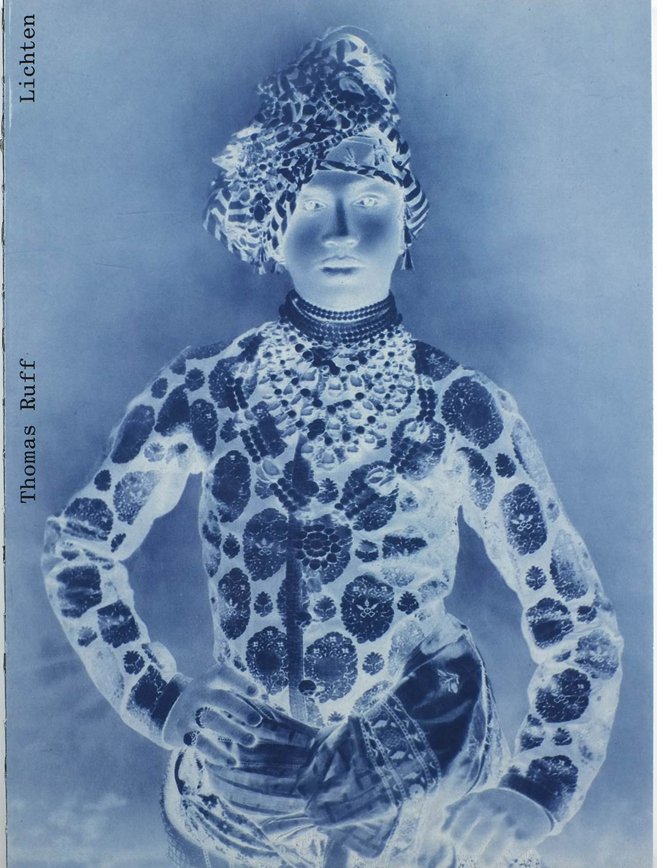
Generally a museum catalogue with many different conceptual works by one artist is not visually appealing to viewers, since it loses the strong focus of an artist book, and it doesn’t speak to the viewers’ minds directly as does a regular narrative-based photo-book. Roma’s “Lichten” is one of the few exceptions to this rule. I have always admired Roma’s excellent books; in my opinion they are one of the best publishers in the world. Because of this book, I appreciate Ruff’s art 100 times more than before, and I am now motivated to learn more about his work.
[divider]
Selected by Nicoló Degiorgis
Nicoló Degiorgis is a photographer trained in documentary traditions who most often works in series. His primary motivation is to observe how marginalised and minority communities carve out a sustainable environment for themselves. He is a founding member of Zona, an association that develops projects to raise social awareness, of the design collective Institute of Friends and of the independent publishing house Rorhof.
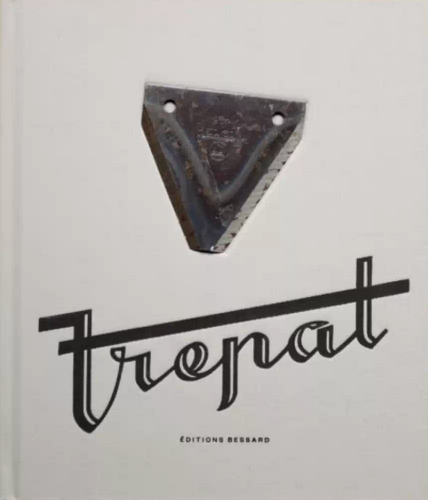
3. PHOTOGRAPHS FOR DOCUMENTS by Vytautas V. Stanionis, Publisher: Kaunas Photography Gallery
This well conceived book is a great example of how to translate an archive of photographs into book-form. Simple and affordable, it has a strong concept and a sophisticated design, without loosing simplicity.

’One day in May’ by Joachim Schmid follows ‘X marks the spot’ and is a documentation of 50 shootings that happened in only one day in May 2014. A book that triggers you to think.

[divider]
1. ! Eamonn Doyle. Self published.
This self published gem of a book shows an older generation of Dublinpedestrians , mainly shot from behind. The photos are both simple and beautiful and is all backed up with an excellent production. An important new contribution to the genre of street photography.
2. Russian Interiors by Andy Rocchelli . Cesura Publish

Just before this photojournalist died while he was working in The Ukraine he was finishing off a project where he had accumulated photos of Russian women who were looking for partners from the West. He originally did this for the women, but then built his own interpretation around the same shooting. The book has been published posthumously and is wonderful production with numerous gatefolds and this series of slightly unsettling portraits.
3. Here and Now: Atomic bomb artifacts. Miyako Ishiuchi. PPP Editions

PPP editions continue to produce very classy artists books, and this year have come out with a stunner. This was a project waiting to happen, as there is no better photographer to go and take photos of the clothes, shoes , and other remnants that survived the Hiroshima bomb, which are now housed in the Hiroshima Peace Memorial Museum. The book is a beautiful production , with no text , apart from the signed minimal colophon , which is inserted. There are hundreds of images, and the book is housed in a bland cardboard cover and slipcase.
4. Congo by Paolo Pellegrin and Alex Majoli, Publisher: Aperture.

Rarely do bodies of commissioned work look this good, and these two Magnum photographers have done a brilliant job in recording and interpreting the less troublesome Congo. Not only are the two photographer’s work unaccredited , but they have also pursued multiple styles : mixing colour , black and white, panoramas and many other formats.
Somehow all this comes together and the resulting narrative makes a compelling body of work.
5. Wild Pigeon by Carolyn Drake, Self published.

Drake has circumnavigated the often difficult second book syndrome after the success of Two Rivers, published in 2013. This book shows images from the Xinjiang Uyhur Autonomous Region in China , where as well as taking her own photos she embarked on creating collaborative images with people she had encountered, as well as digesting the stories they told.
[divider]
Selected by Douglas Stockdale
Douglas Stockdale bio: Douglas Stockdale is a photographer, book artist, photobook reviewer, photobook collector, and independent curator. He reviews photobooks for Emaho magazine and on his influential photobook blog he founded in 2009: The PhotoBook
1. Julia Borissova – Running to the Edge, Self-published

I found this photobook compelling for two reasons; both an interesting subject in conjunction with a brilliant photobook design. As a result of my own book projects, I am a growing fan of those who utilize found photographs to reconstruct and create a new and interesting narrative. Likewise, her attention to detail in creating her book object is amazing, where the book object reinforces, not detract from, the book’s narrative.
2. Paula McCartney – A Field Guide to Snow and Ice, Publisher: Silas Finch
This is a compelling photobook in that her ambiguous subjects, both constructed and photographed, investigate a familiar place for me. I was traumatically introduced to snow and ice as a youth after many years growing up basking in the sunny warmth of Arizona, and this book, much like a talisman, takes me back to those places and times. As a book artist, her collaboration with the publisher, Silas Finch, has resulted in an intriguing complex and layered book object that is designed to be disassembled in order to read; a delight to hold and enjoy.
3. Laia Abril – The Epilogue, Publisher: Dewi Lewis
Abril again investigates a difficult subject, people, but mostly women, who have eating disorders that ultimately have them paying the ultimate price; their untimely passing. She uses a combination of historical family photographs, documents and her own photographs to create her narrative that are mashed up creating a multi-layered book object. The photobook also incorporates some unique book designs (I need to provide a nod to the book’s brilliant designer, Ramon Pez), which is supported by its excellent printing and binding to bring it all flawlessly together.
4. Ed Templeton – Random and Pointless, Pubisher: Deadbeat Club Press
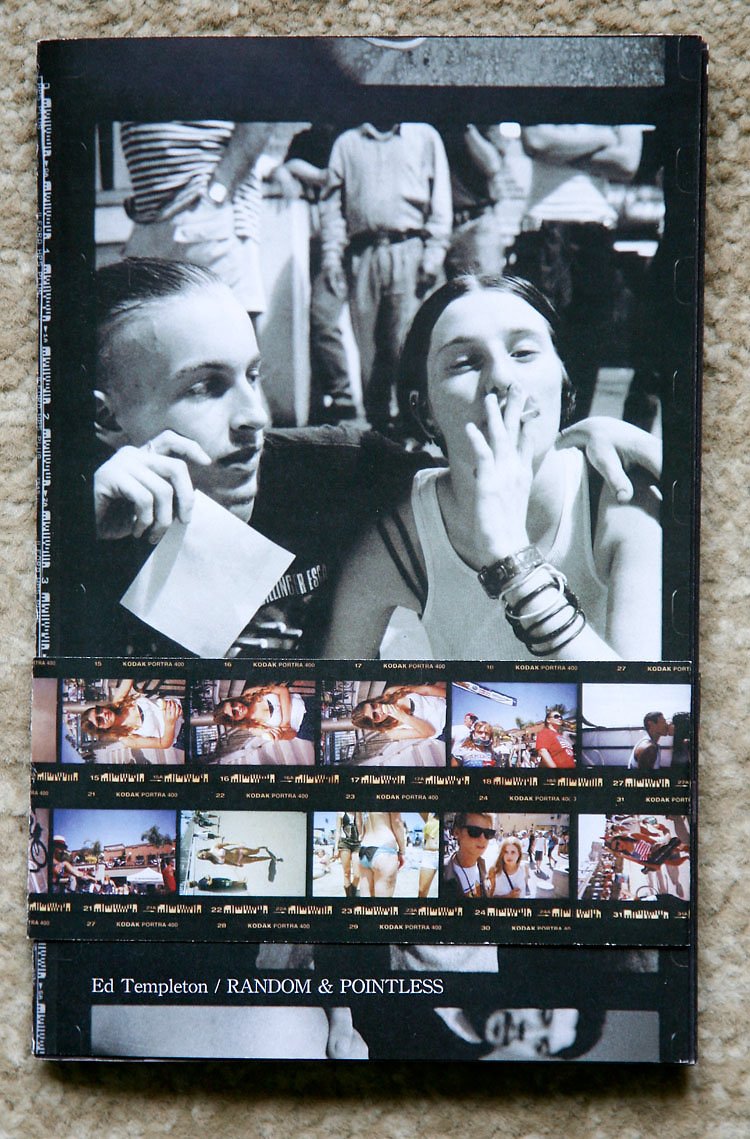
This is a hand-made photobook which Templeton and some of his friends have spent endless hours creating the almost endless foldouts and panels that make this photobook a delight to read. His subject is close to where I reside, the beachside community of Huntington Beach (California), and includes his favorite muse, his wife. Like his grunge photographs, the small book is not very polished with its rough edges echoing a youthful exuberance.
5. Kate Nolan – Neither, Self-published

Kate Nolan’s photobook is a sensitive investigation of outsiders. Her subject are the women who live in a region that has been pushed away the old USSR, but not fully adopted by the neighboring Europeans. Like many of my photobook choices, she has cleverly incorporated an interesting photobook design (in conjunction with the amazing Dutch photobook designer Sybern Kuiper ) to further extend her narrative, bringing together the written narratives of her subjects in conjunction with a mashup of portraits and urban landscapes to further investigate a place. This photobook is open ended and Nolan does not pretend to offer answers, but perhaps create an interesting dialog.
[divider]
Selected by Hisako Motoo
Independent curator and editor based in Japan. Has been organizing many photography exhibitions accompanied with publishing books internationally. Opens new experimental art space, called “AM” (www.am-project.jp) in Tokyo this October. AM was started with Nobuyoshi Araki “Kekkai” and Daido Moriyama “Dazai”.
1. BIBLE by Momo Okabe, Publisher: Session Press

I was excited to meet her works at some photography competition five years ago. Her works were honest and uncovered reflecting herself straightly even they were a little rough-planed. Often the truth is not able to seen in the facts, but I feel her truth really in her photography.
2. Love on the Left Eye by Nobuyoshi Araki Taka Ishii Gallery 2014

Araki lost the eyesight on his right eye in the end of last year suddenly. The right side of these works are almost darkness. His photos give rise to us mixed emotion, because they have everything of our lives: delight, hope, painful, sadness, love, death…This autumn I publish the photography book composed of his instant film works. Each one is cut once and separated two different pieces are combined later by the photographer. I think this book and the latter one “Kekkai” were flowing on the same river conveying the artists’ moments to us.
3. Yoshikatsu Fujii Red String Self-published
I feel this totally hand-made book features the bonds of human. The title comes from some old Japanese saying that a woman and a man who have fate to encounter is tied with red string on their little fingers together. The book shows us a simple thing, a man needs a man anyway. Also I like warmness of the touch sense of this binding by the photographer himself.
4. Sex/Snow Sakiko Nomura
She is one of natural born genuine photographers. Always hunts the subjects and pushes the shutter watching for any chances. The specific point of her photography is to explore and shoot invisible things that are obviously existed around us. Often we can see unfocused dark shadows in dimly light in her photography, even though or cause her skill in shooting is quite excellent, and can feel more than the real through her created images.
5. Back to the Future by Irina Werning, Self-published Buenos Aires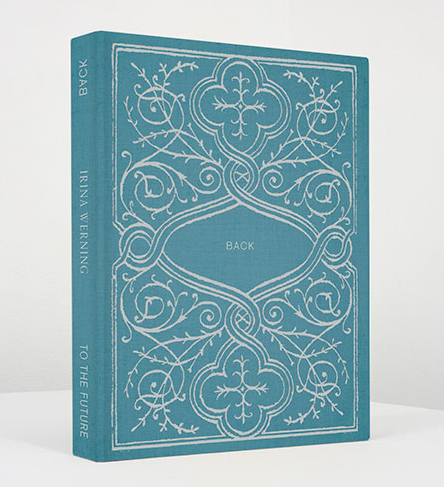
I found this book by the woman in Buenos Aires at Paris Photo as it was nominated Photo Book Award this year. Her approach is unique. She bring somebody back to the past by taking new photos of them. Between two pictures: their passing time are contained . As everybody knows, photograph is reborn again and again in various shapes when it touches new audience in their memory. We observe and imagine someone’s personal history thinking of our own stories.
[divider]
Selected by Carlos Spottorno
Photographer Carlos Spottorno‘s publication The Pigs won the Photobook Award 2013 from Fotobookfestival, Kassel, Germany, and was short-listed for the Paris Photo–Aperture Foundation PhotoBook of the Year Prize.
The “eating disorder” subject has never been under my radar, but when I first opened “Epilogue” I could literally not stop reading it. The whole book was really fitting in my hands, and the pages seemed to flow so easily. This book is so well balanced in terms of content, photography, design, and text editing that should be taken as the ultimate proof of how a good book can make you pay attention to matters you really didn’t care about.
[divider]
Selected by Tomoki Matsumoto
[divider]
Selected by Claudi Carreras
Claudi Carreras Guillén is an independent curator and editor for Editoroial Madalena, Brazil. In 2007 he published the book Conversaciones con fotógrafos mexicanos for Gustavo Gili, Barcelona. Additionally, Carreras-Guillén has curated numerous exhibitions, including Cuba Mía, Front3ra, Transnacional(es) and Estaciones, and most recently, Laberinto de Miradas. Carreras-Guillén was director for the First Meeting of Latin American Photographic Collectives in Sao Paulo in 2008, and is also director of E·CO, an organization supported by the Ministry of Culture of Spain.
With a limited edition of 400 copies, the book presents records from the second trip to Lebanon in 2013, the recent research with tinted wax objects, plus photos, video frames and texts.
The deliberate repetition of these images in the book make clear the character which they have acquired,as enigmatic act, solemn and even poetic.
CENTRO is a personal exploration of São Paulo’s downtown district. Both the images and the objects photographed are a direct result of transformation. The city is seen empty and like an archeologist Felipe searches for what was left behind. Objects and man made construction are the material where the photographer looks for order and evidence. The city becomes a space of silence where matter seems to have its own vitality and the smallest mark gains meaning and significance. It is seen as an accumulation of constructed objects that gain value for what they are for their physicality and for what they become when photographed.
[divider]
Marcelo Brodsky is a photographer. His most known work is Buena Memoria, an essay on state violence in Argentina. He is the founder of Latinstock, a network of Latin American picture agencies. He has worked in Human Rights and Photography, and is the founder of the Parque de la Memoria, a memorial institution in Buenos Aires that remembers the victims of the dirty war. He was a member of the editorial board of the Latin American Photo Book. He is currently working on a project that combines photography and human rights, www.visualaction.org
1. Periscope by Jose Diniz, Publisher: Editora Madalena, Sao Paulo, Brazil
 Jose gave away what he was doing and decided to concentrate on Photography. His first major project was to make a book of his images taken on the seaside in Brazil; in fact, they were taken from the sea. Jose photographs the people who come into the sea to have fun or to enjoy nature. The sea becomes a character with its own vision, and it recognizes the visitors and its sorroundings. It is an essay on the point of view, placing it beyond the human eye. The sea is given a vision.
Jose gave away what he was doing and decided to concentrate on Photography. His first major project was to make a book of his images taken on the seaside in Brazil; in fact, they were taken from the sea. Jose photographs the people who come into the sea to have fun or to enjoy nature. The sea becomes a character with its own vision, and it recognizes the visitors and its sorroundings. It is an essay on the point of view, placing it beyond the human eye. The sea is given a vision.
The images are playful and they suggest to the viewer that nature can have its own eyes, and receive humans with an attitude.
2. Esto ha sido (‘This has been’) Luis Weinstein, Self – Published, Santiago de Chile

Luis goes back to the files and he edits from his images taken during the last 30 years, including the times of the dictatorship of Pinochet, until recent times. With his black and white files he creates a new narrative, a book that is a fresh look at his production. Shooting ordinary people, normal men and women in their daily lives, we can feel there is something underlying their faces and their body language. What is happening can be identified image after image, and it is a mixture of fear and despair that portray a society that is leaving the dictatorship behind but still has plenty of social issues to solve. The way in which Luis faces this transition is rich, ambitious and abiguous, and it is open to multiple interpretations. Texts and numbers within the images are criptical references to hidden stories, that drive the reader through unresolved stories. The viewer decides.
3. Un Horizonte falso Alberto Garcia Alix, Publisher: RM Editores
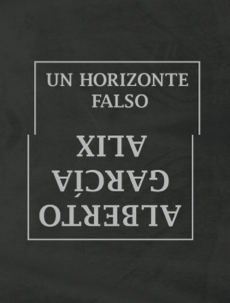
Alberto Garcia Alix recreates his own myth as a motorcyclist shooter and produces a new body of work based in a poetical look at the world. Portraits, trees and motorcycle shadows mix in an exquisite book that resignifies Alberto`s work and can be read as a poem, a self-portrait and an architecture of his world. Alberto is known for his work in portraiture, and in this essay this genre is extended to nature. Not the motorcyclists, but their shadows tell the migrant movements of motor and rootlessness. The book is superb in its paper and printing, hightlighting the photographer’s subtlety and original approach to life.
4. Amazogramas Roberto Huarcaya, Self-published

This book reproduces an unique body of work, an attempt to conceive of the inmensity of the Amazonian rainforest with a picture essay. Unable to reach satisfactory results with his câmera, Roberto Huarcaya decides to print the actual jungle on paper, and he produces a rayogram, a contact sheet of sensible paper that is inprinted by the light of the jungle. The sheet is 110 meters wide and 30 meters long. An inmense work that is carried in the jungle by a photographer and his assistants looking for light impressions within the humidity of the wildest of spaces. And the result is brilliant, misterious, beautiful. The book is then displayed as a reproduction of that single print, and Split into three rolls of paper, each on a roll. They look like a Torah, a Jewish Bible, and must be read unrolling its paper. This is a wonderful exercise that takes the viewer to a real jungle, rebuilt on paper with care and thought.
5. La camara afgana Rodrigo Abd, Publisher: KWY Ediciones, Lima, Peru

A.P. photographer and Pullitzer prize winner Rodrigo Abd goes to Kabul with his digital camera to shoot. But walking through the city, he notices that local street photographers use large wooden cameras to take portraits of the Afghans. So he decides to learn how to use these large format cameras, and to start a project to take portraits of Afghan citizens using this traditional format. This return to the basic prínciples of photography captivates the photographer and he starts obtaining results that are totally different, as they are based on this traditional technique. The portrayed look directly to the camera, they are still and defiant. The resulting portraits are the center of his Afghan experience, not his war shots. They enabled him to connect with the people of Afghanistan in a way he could not even dream of when shooting a car bomb or a street combat with his digital camera.


